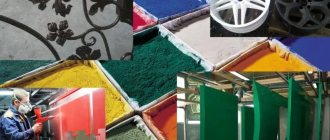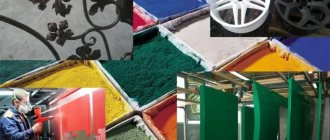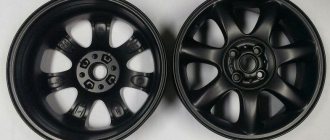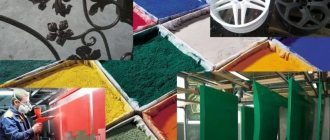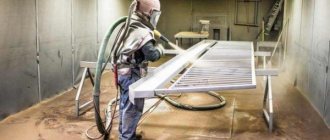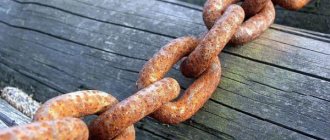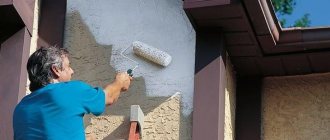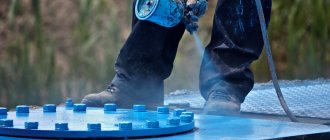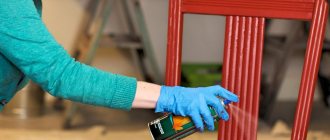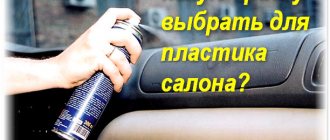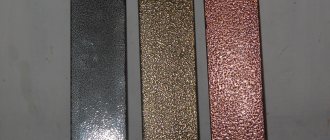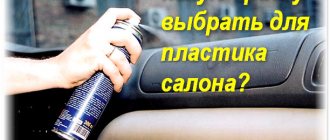Types of powder paints
Powder paint is a material with colored pigment in powder form. It protects the metal surface from moisture and prevents rust. Durability, additional strength and even electrical insulation are its features.
In addition to the pigment, the composition also includes other substances: resins form a film, and catalysts are responsible for hardening. Powder coating is common in construction, automotive and interior design. This way you can achieve a matte or glossy, voluminous or flat surface.
Paint is divided into 2 types:
- Thermoplastic. The decisive factor here is high temperature. Resins are added to the composition: vinyls, nylons or polyester. After heating, they form a hard coating preserving the composition and structure of the original raw material. This powder coating allows the metal object to be reheated and the layers re-formed.
- Thermosetting. Film formation occurs as a result of a chemical reaction. Acrylic, epoxy or polyester resins are used to produce paints.
You can paint objects of any size and even with a complex design Source rzsd62.ru
Thermoactive colors are suitable for products that are used in harsh climatic conditions. Once applied, the powder coating reforms and does not deform when reheated.
The components in the composition are safe. They have a high degree of flowability, which is why they do not stick to objects and skin. The shelf life is unlimited, the color does not fade, and the consistency does not thicken over time. Properties are preserved until the moment of use. No solvent needed.
See also: Catalog of companies that specialize in paints and varnishes and related work
Which is better, powder painting or enamel?
This comparison reveals additional positive and negative aspects of staining:
- Compared to enamel, “powder” is more environmentally friendly and does not cause as much harm to the environment as liquid dyes.
- When painting with enamels, a large amount of waste is generated; painters use 100% powder.
- The physical and chemical properties of finished products are better in all respects than powder coating. Parts are better preserved, last longer, and are less susceptible to corrosion.
- Powder paint is superior in ease of use when working with complex terrain. Thus, high-quality painting of calipers with enamel is almost impossible, and powder spraying turns this part of the car into the most spectacular part of the design.
- The ability to quickly change the shade is higher with powder coloring technology. Repainting enamel is much more difficult and takes longer.
- Powder paints are odorless, and the surface film is important for further transportation of the product. It does not scratch or crack when impacted.
- Enamel has wide limits of use. Powder paint is limited to the high temperature region (150 -200 °C).
- Basic powder application equipment costs several times more than equipment for liquid dyes.
- The processing of parts with powder paints is limited by the area of the polymerization chamber. Large indivisible products have to be painted “the old fashioned way.”
- Applying the powder in a thin layer requires a highly qualified craftsman.
- Use at low temperatures is more suitable for enamel.
This comparison shows more advantages of powder coating, which explains its widespread use in some areas, such as the care and restoration of car wheels. The Tuningberg service offers customers powder coating of discs and calipers. Detailed information on our services page. There you can see samples of our work and learn about quality guarantees.
Dyeing technology
When powder painting, painting technology is of great importance. The idea is to spray dry particles onto a degreased and cleaned surface. Positively charged paint particles easily stick to a negatively charged metal surface. This creates an even and uniform layer.
Only two spraying methods are used:
- Electrostatic . Electrostatically charged powder is applied to the grounded surface. This is done using a powder coating gun. Kohler acquires an electrical charge due to ionized air. It is located in the corona discharge area and is formed between the electrodes of the charging tip and the surface to be painted.
Electrostatic Painting Source graco.com
A high voltage source is built into the sprayer design. The main disadvantage of this method is the inability to apply paint into small depressions and recesses.
- Tribostatic . This method uses compressed air. As a result of friction with the dielectric, a charge appears. It holds paint molecules on the surface being painted. The dielectric is fluoroplastic - the atomizer is made from this material. This method is used for painting products with complex geometry. It is possible to use multi-jet nozzles, which increase the accuracy and uniformity of paint application.
The main advantages and disadvantages of powder dyes
This material has gained a leading position in the finishing materials market. Positive qualities include:
- high anti-corrosion. Polyester paint can last more than 10 years;
- durable coating;
- does not require preliminary priming. Here it is enough to level the surface for painting;
- environmentally friendly composition;
- uniform coverage;
- ease of application;
- has good electrical insulation;
- durable protection.
In addition, this paint dries quickly and does not leave smudges. Thanks to this, the surface looks perfect. For example, epoxy paint is highly protective. That is why it is often used to decorate wooden elements.
The negative qualities of this finishing material include:
- acrid odor;
- aggressiveness of chemical reagents.
Stages of work
Powder coating technology consists of three stages of work: surface preparation, painting and polymerization.
Surface preparation
It includes: cleaning from contaminants, degreasing, phosphating.
Dirt, rust and oxides are removed from the surface of a metal product. If you skip the cleaning step, the paint will peel off and you will have to redo it. The best cleaning method is shot blasting. Small granules are directed to the surface under pressure or using centrifugal force. Cast iron or steel granules, as well as sand, are used as granules.
Dyeing process and physical features
Powder coating what is it? This is a popular question. After all, the process is strikingly different from the usual use of liquid paints. In this case, we can say for sure that the resulting result is of a higher quality. There are several ways to carry out powder coating on a surface; it is selected based on the type of colorant of the product that will be painted.
The resulting result is of a higher quality.
Stages of work
Before painting, preparatory work should be carried out so that the item is as prepared as possible for processing. In general, the following steps are performed:
- Cleaning the product from all types of contaminants and degreasing.
- The powder is applied with a special spray gun.
- Heating is carried out with further cooling.
On an industrial scale, painting is carried out in special chambers. In them, powder fractions are distributed over the surface and charged with electricity, which allows them to securely attach to the surface of the object. A special spray can be used that creates the necessary charge on a particle of powder for magnetic induction to occur.
After the substance is distributed over the surface, polymerization is carried out, which is done with the aim of getting particles into all the pores of the surface. After gradual heating, which can reach +250 degrees, cooling occurs naturally.
Work must be carried out wearing protective glasses, clothing and a respirator.
On an industrial scale, painting is carried out in special chambers.
Video description
This video shows how to clean rust from metal.
Chemical cleaning or etching is suitable for degreasing the surface before powder coating of metal products. Sulfuric, nitric or phosphoric acids are used as a reagent. Phosphating is similar to priming. When treated with a special composition, a phosphate film is formed, which improves adhesion.
Coloring
For these purposes, a special room is equipped - a chamber - with a forced air suction system. Large-sized products are painted in walk-through type chambers, and small parts are painted in dead-end type chambers. A special gun sprays the color. The step-by-step process looks like this:
- Powder paint is poured into a special hopper and mixed there with air. The proportions are adjusted using valves.
- A mixture of paint and air passes through a spray gun with a high-voltage source, acquiring a positive charge.
- The process of spraying paint onto the product occurs.
- The last step is extraction to remove loose particles. Entering a special bunker, they are again sent through the painting cycle.
Metal paint for external structures: properties
For the first time, paints of this type began to be used in the 60s of the 20th century. Since then, their production technology has been improved and developed. The first advantage of powder paints is the lack of solvent in them. Instead, air plays the role of a dispersed medium. The properties of dry paints differ significantly from their liquid counterparts. It is better in both economic and environmental characteristics.
Film formation parameters are achieved thanks to solid particles and film-forming resins.
Depending on the presence of special coloring pigments, all coloring systems are divided into pigmented and non-pigmented. The latter are used for application as varnished surfaces.
See also: Heat treatment of metal
Video description
This video shows the consequences of underbaking and overbaking paint.
The process of paint polymerization occurs. It takes 15-30 minutes to complete the full cycle. Microparticles of powder paint are melted, forming a film, then hardened and cooled. The time for this stage depends on the size of the part, the type of oven and the type of paint.
The temperature required for the process is kept in the range of 150-200 °C. After which the molten powder fills all small irregularities, this guarantees tight contact between the paint and the surface.
Then the part is cooled. The coating becomes durable, and the product receives protection from adverse environmental influences.
Video description
This video shows the powder coating process
- To spray powder materials, use the minimum required amount of air. When oversaturation occurs, there is an increase in color consumption, increased load on the equipment, disruption of the electrification process, changes in the granules of the powder material, plus, visibility in the spray booth noticeably deteriorates.
- Use air of the best quality, without impurities.
- Carefully homogenize the powder mixture before use.
- Do not mix different colors. Before using a new color, thoroughly clean the equipment.
- Pay great attention to surface preparation before painting.
- Storage conditions for powder paints must be observed to avoid deterioration of the raw materials, which will affect the final result.
- The technological process must be followed in detail at all stages of painting work.
- Monitoring, prevention and maintenance of units is a necessity.
- Correctly configured production cycles guarantee a reduction in the loss of coloring pigment to 2% -5%.
Rules and recommendations will help achieve uniformity and elasticity of the coating, as well as a long service life.
Stages of dyeing at home
To independently coat metal surfaces with powder-based paint, you need to prepare specialized equipment and study the features of the technological process.
Tools and equipment
To carry out the work you need to prepare:
- painting chamber (work cannot be performed outdoors);
- powder paint;
- spray gun;
- oven for drying parts.
You can assemble the furnace equipment yourself.
Surface preparation
Features of preparation of metal surfaces:
- Clean the workpieces from dirt, rust, and plaque.
- Remove scale with a grinder or grinder.
- Remove light stains with acid.
After cleaning, the surfaces must be degreased with a solvent.
Sanding machine (Photo: Instagram / inalliance)
Application of the composition
Metal painting process:
- The workpiece must be secured in the painting booth, and dry powder must be applied with a spray gun. The tool must be kept at the same distance from the part on all sides.
- You can collect the remaining powder using a special device - a recuperator. If you don't have one, you can use a cyclone-type vacuum cleaner.
- Start the oven. It should be located in a well-ventilated area.
- Place the part inside for 30 minutes so that it lies on a grounded frame.
The product can be used within a day, when the decorative layer is completely dry.
Briefly about the main thing
Powder paint is a modern type of painting materials for metal. The scope of application ranges from painting small household appliances and interior items to metal structures.
There are two main types of powder paints - thermoplastic and thermosetting. The choice of method depends on the tasks at hand. There are also only two types of dyeing technologies - electrostatic and tribostatic. In the first case, a powerful high voltage source is used, in the second it is absent.
Painting is done in 3 stages: first, prepare the surface - clean it of dirt, dust and old layers of paint. Products are painted using an air suction system. The final stage is polymerization. The painted object is sent to the oven to fix the paint, followed by the processes of hardening and cooling.
Ratings 0
Preparing for painting
Regardless of whether polyester powder paint or epoxy powder paint is used, the preparation step is no different and must be followed perfectly.
The preparatory stage is the most important, because the quality of applying paintwork to the coating depends on it.
- First of all, using an ordinary rag, you need to thoroughly wipe the surface to be painted from dust and other contaminants. It is recommended to repeat the procedure twice to remove all interference.
- Using metal brushes or sandpaper, you need to clean those areas of the material where corrosion (rust) has begun to appear. If there is no corrosion, this step can be skipped.
- Next, you need to degrease the surface of the part to be painted, this will increase the reliability of contact of the paint with the surface, rid the material of various greasy stains, etc.
- At this stage, the material is primed, this will eliminate the risk of air and contamination. For this purpose, inorganic-based paints and varnishes are used.
- After this, a layer of sodium and chromium nitrate is applied to the part on top. Passivation will protect the part from corrosion in the future, which will extend its service life.
- After these manipulations, the workpiece must be dried in the oven.
If the part is heavily soiled and has a rather complex structural shape, it must be cleaned in an alkaline solution, where the part is placed for a certain time.
